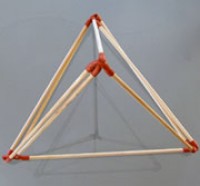TetraMap’s competitive edge
TetraMap is Edgy
Six edges to be exact (when folded up into a tetrahedron). The tetrahedron is TetraMap’s competitive edge: Edgy-ness is an excellent metaphor that reflects: risk – standing on the precipice – being provocative, a little confronting even.

- Reduce conflict – Each face of the tetrahedron shares edges with each and every other face. This illustrates how everything affects everything – inter-dependence – and provides a tool to explore ALL points of view, not just the conflicting ones.
- Provoke creativity – It’s easiest to focus on the Elemental faces, consider however the edges where the Elements blend and blur. Exploring these blurry regions often spark the need for deeper conversations and blended solutions.
- Supersede best practice – Rather than making your future dependent on someone else’s best practice, use TetraMap to develop your own expertise in next practice. TetraMap and the tetrahedron give you that edge in our world of constant change.
- Shift mindsets outside the box – TetraMap is NOT a four quadrant behavioural model based on opposites which put people in boxes. TetraMap is an intuitive framework of relationships that can be applied not just to behaviour but also to the nature of teams, planning, sales & service, performance, leadership… in fact, any system!

Bucky said, “The tetrahedron is the minimum and simplest structural system in Universe“. Organisations are systems and it makes sense to try and understand them in terms of their natural building blocks.
Peter Senge said in his 1-hour video, Systems Thinking for a Better World: “It seems to me that there is one problem in the world, and all the problems in the world arise out of this one problem. And, as I understood it then, the problem was inter-dependence. […] How do we start to close the gap between the inter-dependence we create and the inter-dependence we understand? How do we understand the ways of thinking and being that will be required?“
Samar Singh commented: “Really insightful talk – and no powerpoint! […] The intuitive thought that comes to mind is: how can we train people to lead like that?“
Consider how TetraMap is a tool for cultivating systems thinking to help us all understand inter-dependence better. At least watch, Navigating Webs of Inter-dependence (5 mins) if you don’t have time now for the longer video.
By the way, we spell inter-dependence with a hyphen on purpose, because it is so easy to misread the word as the much more commonly used, independence.